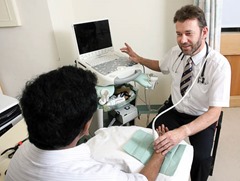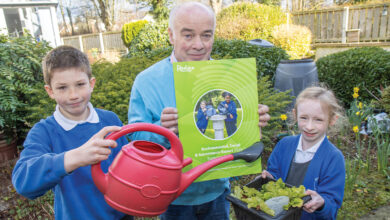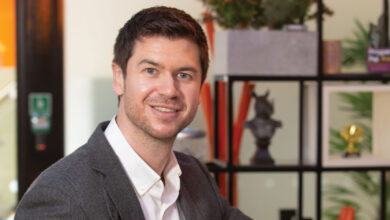Joining up and improving care
 Integrated care partnerships are an important new structure for the health and social care system. Peter Cheney meets a range of people involved in setting them up and hears how joining up the system should improve care for patients.
Integrated care partnerships are an important new structure for the health and social care system. Peter Cheney meets a range of people involved in setting them up and hears how joining up the system should improve care for patients.
From next April, the 17 integrated care partnerships (ICPs) will be designing and co-ordinating services for their local populations as a key part of Transforming Your Care reforms. For many people outside the health and social care system, the term ICP may sound like the latest government buzzword but their members genuinely believe that this way of working can improve the quality of life for the people in their areas.
Each ICP will cover around 100,000 people, as outlined in the listing later in this article, and will include every group that is involved in health and social care. A partnership will ideally have twelve or thirteen members:
• four from the local health and social care trust (a medical specialist, a nurse, a social worker and an allied health professional);
• one from the Northern Ireland Ambulance Service;
• two general practitioners;
• two community pharmacists;
• two members who are either service users or carers; and
• voluntary and community sector representatives (a minimum of one and preferably two).
The phrase ‘service user’ means a patient in the Health Service or a client who is receiving social care. ICPs will initially focus on five clinical priorities: stroke, diabetes, respiratory conditions and general frailty in old age. Over the summer, the Patient and Client Council has been asking patients in each of these groups if they would like to become involved in ICPs.
agendaNi met four people who are helping to establish ICPs to find out how the process is developing and how they hope it will improve outcomes for patients.
Dr Brian Dunn is the GP lead for the ICPs in the south eastern area while Christine Breen is the Health and Social Care Board’s business manager for that area. Peter Wright is the pharmacy lead for the West Belfast ICP. Justine Brown, a community worker with the North Belfast Partnership, is the interim ICP community representative for North Belfast.
On the involvement of service users, Christine Breen explains: “There has been quite a good bit of positive feedback with people wanting to join both the committees and also some very specific ‘task and finish’ groups to work around pathways for the different clinical priorities.”
“We all tend to work within our own clinical bubble, as regards GPs and pharmacists,” Peter Wright acknowledges. “You’re still dealing with those patients and you’re listening to that [feedback] everyday but you’ve got to open your mind a bit to the bigger picture and that’s what these ICPs, I think, are going to do.”
At the moment, Brian Dunn relates, the Health Service reacts when a person becomes unwell. TYC will move care from being reactive to being pro-active e.g. better prevention of ill-health, people managing their own conditions, and ‘buddy groups’ in which patients with the same condition will support each other.
 Justine Brown remarks that her sector is keen to see the medical and social models of health being integrated. The medical model focuses on treating ill-health whereas the social model builds on that and looks at how the environment, housing and lifestyle choices influence a person’s health and well-being. “It’s integrating the two,” she emphasises. “We don’t see that they can function or exist in isolation.”
Justine Brown remarks that her sector is keen to see the medical and social models of health being integrated. The medical model focuses on treating ill-health whereas the social model builds on that and looks at how the environment, housing and lifestyle choices influence a person’s health and well-being. “It’s integrating the two,” she emphasises. “We don’t see that they can function or exist in isolation.”
The community sector in Belfast has been involved in the primary care partnerships; these are forums of primary care staff which have acted as a forerunner for ICPs. These partnerships sought to improve a service in each quarter of the city: palliative care in the north; diabetes care in the south; ear, nose and throat services in the east; and environmental health in the west.
Brian Dunn points out, though, that Belfast is fortunate to have a “very strong” voluntary and community sector but other areas don’t have the same number of organisations: “Part of what we need to do is identify people who are working on the ground and start to build them up and allow them to develop.”
The largest cohort of volunteers, he notes, are people retiring at 60 who are fit, well and have “lots of time on their hands” – and he wants to encourage them to put something back into their community.
Roles
The role of the ICP support teams, Breen explains, is to guide the ICP members who will then take forward the changes. Her team will ensure that people on ICPs are focused on what they want to do within the next three months, six months or year.
In West Belfast, Wright remarks, the ‘Healthy Hearts’ project has involved 10 pharmacies in vascular screening and weight managements. For the first time, many people are finding out the full range of services that a pharmacist can provide even though pharmacists assumed that this was already known.
Over the last year, West Belfast pharmacists have also signposted an unprecedented number of patients to community support groups for additional help e.g. counselling, exercise or other activities that overcome social isolation. He adds: “In a way, I take that example and bring it to an ICP where you’re getting everybody working together and you’re identifying those patients who need the help.”
Brown remarks that the different bureaucracies and cultures in organisations mean that it can take a lot of time to build working relationships. As an interim representative, she sees her job as facilitating conversations within the local community and letting professionals know who they can work with.
“We’re not there in an expert medical role,” Brown says of community sector representatives. “We’re there as a connector.”
In the past, care has been designed around large buildings, rotas for health professionals and funding streams. “I think this gives us a chance to design care around the patient,” Brian Dunn says. ICPs should change the culture so that care is provided “in the community as close to the patient’s home as possible.”
Learning points
Taking a holistic view of the patient has been a learning point for Peter Wright. The “interface” between primary and secondary care still matters and it is important, in his view, to have hospital representatives on ICPs. This will help them to understand what the ICP is trying to do for the patient.
Pharmacists must also improve the system for patient discharge notes, which works “seamlessly” in some areas but not elsewhere. Three-quarters of people aged over 75 are taking prescribed medicines and 36 per cent of older people in general are taking four medicines or more.
“It’s so important to get it right and to let the patient know,” he says as a patient sometimes does not understand why their medication has been changed. The growing population of older people will result in a higher volume of chronic conditions that will need to be treated.
Indeed, as people are now living longer, Justine Brown sees a need for early intervention to start in childhood: “You might not be making an impact in the next five years but in the next 20 years.” The board needs to create the right environment for people to communicate with (and properly understand) each other. “Clarity around roles and responsibilities is absolutely paramount,” she states.
In her view, the increased focus on primary care (known internally as ‘shift left’) is not just about improving community services but also identifying the right service for a patient. And this may mean keeping a person in hospital. Care at home is seen as a “utopia” but it could also increase the pressures on a patient’s relatives.
“I think secondary care is under pressure and we’re not asking them to work any harder,” Dunn adds. “What we’re asking them to do is work differently.”
The ideal in Transforming Your Care is that fewer people go to hospital, those who need hospital treatment are admitted and treated more quickly, and good services in the community support a person’s recovery once they are discharged. Patients will also have to take on more responsibility for their health through their eating and exercise habits.
Christine Breen has enjoyed learning about how every member of the ICP works. “The common thing is the patient,” she comments, “and I know people do say that quite a bit but genuinely I feel that, from the ICP level, if we keep the focus there we can make really good improvements.”
Practical outcomes
That point leads well on the final question: what practical outcomes do they want to see coming out of the partnerships?
Good co-ordination and co-ordinated prevention stand out for Justine Brown. This will help local communities to make good lifestyle choices and therefore help to prevent chronic conditions.
Peter Wright points to some of the outcomes already delivered by the ‘Healthy Hearts’ project. Patients in West Belfast can be signposted to three ‘health hubs’, where the voluntary and community sectors can provide extra help.
One patient with depression received counselling in a community setting and found that isolation was the cause of the problem. Meeting and talking with people and taking exercise helped them to get better – all of that support came from their community. “What you’re asking that patient to do is self-manage,” Wright continues. “It’s giving them the confidence to go out there and see a big picture and realise that they can make a change.”
Christine Breen wants to see more momentum, now that people are understanding the purpose of ICPs. “There are an awful lot of good ideas that have come to the table already,” she remarks. “An outcome for me now is to try to make some of that actually happen.”
“We’d like to see a shift in diagnostic services from hospitals to general practice,” Brian Dunn comments. “If we can get direct access, it’ll save those waiting lists. It’ll save people waiting around in casualty for ages.” He also wants to get more feedback from patients and carers about how services are working.
So far, Dunn notes, the South Eastern Health and Social Care Trust and its ICP representatives have been “in general agreement about the road we want to travel” but that, in itself, is not the goal. “It’s not about having meetings and it’s not about saying the right things,” he concludes, “but it’s whether we can actually deliver change to our services, to the benefit of the patients.”
Where will the ICPs cover?
Listed by health and social care trust area
Belfast
- North
- South
- East
- West
Northern
- Antrim-Ballymena
- Causeway
- East Antrim
- Mid Ulster
South Eastern
- Ards
- Down
- Lisburn
- North Down
Southern
- Armagh-Dungannon
- Craigavon-Banbridge
- Newry and Mourne
Western
- Northern sector (Derry, Limavady and Strabane districts)
- Southern sector (Fermanagh and Omagh districts)





